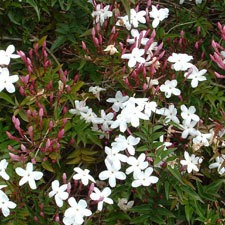 Jasmine
Jasmine
Common name: Jasmine
Botanical name: Jasminum polyanthum
Management category: Advisory
Originally from West China. It was introduced to New Zealand as an ornamental species and was recorded as naturalised in 1980. Jasmine can live up to 15 to 20 years in the wild.
Why is it a pest?
- Grows rapidly to smother and kill all plants from ground level to high canopy and suppresses regeneration.
- Runners spread long distances over tough sites, highly shade tolerant and can flower under full canopy.
- Very tolerant to various conditions and soil types and extremely hard to kill.
Where is it found?
- Birds readily spread seed where it is produced. Most spread is from fragments dumped in greenwaste, and common sources are gardens, roadsides, vacant land, cemeteries, and bush tracks.
- Open and intact forests and forest margins, coastline, cliffs, shrublands and streamsides. It can invade cold-climate forest if there is dense canopy cover.
What does it look like?
- A perennial, evergreen, climbing almost hairless, non-woody vine with very long, round, tough, stems.
- Clustered, tube-like white flowers that are pink when in bud and very fragrant (January to December). Very rarely glossy black berries develop after flowering.
What are the rules?
Advisory
Council does not enforce the control of advisory species. It is landowner/occupier responsibility to manage these pests. Council may provide advice on how to manage or control advisory species if required.
How to get rid of it
- Cut and Paste (all year)
- Spray (all year)
CAUTION: When using any herbicide or pesticide, PLEASE READ THE LABEL THOROUGHLY to ensure that all instructions and directions for the purchase, use and storage of the product, are followed and adhered to.
Read more on pest control advice, information and regulations.
Images





